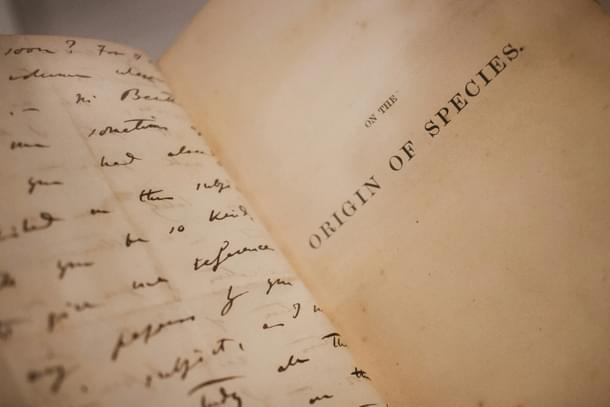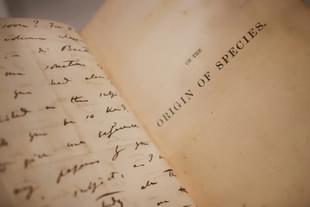Science
Darwin Day: Beware The Disturbing Trend Of Hindu Creationism
Aravindan Neelakandan
Feb 12, 2024, 06:49 PM | Updated 08:41 PM IST
Save & read from anywhere!
Bookmark stories for easy access on any device or the Swarajya app.


The Rashtriya Swayamsevak Sangh (RSS) magazine Organiser carried an article (dated 5 June 2023) by a former vice chancellor of Gautam Buddha University arguing in favour of the ‘logic of deleting Darwinism’ and ‘Intelligent Design'.
It was shocking because the third all-India head (sarsanghchalak) of the RSS, Madhukar Dattatraya Deoras, in one of his famous talks spoke about how the West, despite its religion-motivated psychological inhibitions, had embraced Darwinian science, citing the famous Scopes Monkey Trial.
Deoras asked Hindus to learn from this approach with respect to abandoning casteism. Incidentally, belief in a birth-based varna system is social creationism, and as absurd and even more perverse than biological creationism. But that is a topic for another day.
The essay published by the authoritative RSS mouthpiece is a worrying indication of the creeping in of a fundamentalist creationist tendency that is more an imitation of Western creationism, and a vision alien to any Indian darshana, but, more importantly, a falsehood.
Two of the major fallacies in the Organiser article are discussed here:
No Fine-Tuning
The first fallacy is the evidence of intelligent design in the universe — the "fine-tuned universe" argument, put forth by thirteenth-century Christian theologian Thomas Aquinas.
Centuries before Charles Darwin, that gentle yet profound, non-dualist seer of Western philosophy, Baruch Spinoza (1632-1677), had shown the fallacy of this argument for creationism.
According to Spinoza, it was because people are "ignorant both of things and their own nature" that they conclude that god had created things in order.
People superimpose their own actions having a purpose on to the universe, he said, though he strongly considered all things as contained in the Divine.
In his article, Professor Bhagwati Prakash says:
The gravity, mass and velocity of each of these celestial bodies and trillions of their formations in group or cluster are so fine-tuned with each other that their centripetal and centrifugal forces ensure steady movements over billions of years without any collision or escape from the orbits.
The collisions of stars, galaxies, and black holes is well-known in astrophysics. Therefore, the claim that "each of these celestial bodies" as being "so fine-tuned" to "ensure steady movements over billions of years without any collision" is an erroneous claim.
The Eye Evolved, It Was Not Designed
Next: the oft-repeated claim that the extraordinarily precise design of the human eye is proof of intelligent design.
This claim is, in many ways, the beating of a dead horse. It is unfortunate that Hindu nationalists should choose to recycle such decades-old, second-hand arguments of Christian and Islamist creationists.
The evolution of the eye, like the evolution of all other organs, has a long history. The science of evolution and the process of adaptation and natural selection can explain the evolution of the human eye with all its features.
The first eye discovered in fossil history is the one we find in a trilobite, Olenellus fowleri. It lived before the Cambrian explosion. Then, there was the evolution of the compound eye, which we see even today in insects.
In the evolutionary history of life, several models of the eye have been experimented by nature and adapted in specific niches.
For example, in cephalopods — the animals among which are octopuses — we see an ancient organism, nautilus, which evolved 500 million years ago (mya). Its eye is a pinhole camera and has no lens and no cornea.
Then, we see from the same cephalopods, octopuses emerge later. Here, the model had evolved substantially with their eyes, including now a lens, a horizontally oval pupil, and a highly sophisticated system of muscles associated with the eye called extraocular muscles.
So, one can see how evolution slowly shapes organs as befitting their niches.
To cut the long evolutionary story short, let us come to the human eye:
The human eye is a primate eye. Even as we marvel at this wonderful achievement of evolution in bringing forth such an eye, we should say that in the course of this evolutionary journey we also lost quite a lot of interesting features.
For example, the eyes in humans along with other mammals lost three of five opsins which form the basis of visual pigments. As against this, lampreys, considered one of the earliest vetebrates, have all five in their eyes. The mantis shrimp has as many as 16 visual pigments.
We also lost, along with other placental mammals, coloured oil droplets, which are still conserved in the early four-legged animals and also in some marsupials, turtles, and birds.
The primate retina, which includes the human species, is not as complex as the retina of many birds or some turtles. Ivan R Schwab, an authority on the evolution of the eye, says:
In many ways, our brain receives an inferior image from our eye, as compared with the rich, robust images received by some other animals. Humans simply do not have the best optical device in the animal world, but the brain helps us with these deficiencies.
The human eye also has some unique features which confer upon us evolutionary advantages. While most visual tasks occur for birds in their retina, for us they happen in the brain. In other words, their eyes help speed up their responses.
Our eye-brain mechanisms evolved for understanding the visual context of stimuli. In other words, each and every feature of the eye has evolved gradually and through selection processes over many, many million years — right from a light-sensitive pigment in a single-celled animal to what we have in primate and bird eyes.
The eyes we have today evolved over deep geological times through selection pressures with a lot of evolutionary trade-off. The ‘design’ is, thus, a fallacy.
The Hindu View Of Evolution?
The question is, if we are to understand evolution from a Hindu point of view, how should we do it?
Lokmanya Tilak once famously said this about untouchability:
Vedas do not accept untouchability. But if Vedas accept untouchability then I would reject the Vedas.
We need to follow the same principle. The Indian knowledge system does not reject evolution, but if it does, then it is not a knowledge system but rather a system of sophisticated ignorance.
Hindu seers like Swami Vivekananda and Sri Aurobindo have argued for the acceptance of evolution and considered it through the framework of Sankhya.
In fact, Deoras brilliantly associated the way Christendom by and large had accepted biological evolution with the need for Hindus to reject social creationism:
However, today, no Christian gives credence to that story of evolution in the Bible; but still they have not tried to destroy their faith in the Bible. This may appear strange, but, has a great lesson for us. Spirit Eternal, Forms Ever New Such problems are common to all countries. Solutions must be found for them. Whenever I speak like this, some people say that these are things created by God. It is their intention perhaps to impress upon us the idea that such things cannot be changed or amended because they are created by God. But how far can this argument stand? God Himself has declared, “Whenever Dharma declines, I reincarnate myself.” However, the re-establishment of Dharma after its decline does not mean that the old order will be re-established without any change whatsoever.
The disturbing question is, is it because of the very same reason that there are elements in the present-day Sangh Parivar who try to embrace creationism?
References used:
Schwab, I. The evolution of eyes: major steps. The Keeler lecture 2017: centenary of Keeler Ltd. Eye 32, 302–313 (2018). https://doi.org/10.1038/eye.2017.226
Ivan R. Schwab, Evolution’s Witness: How Eyes Evolved, Oxford University Press, 2012





